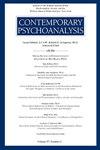On Paul Lippmann
IF 0.2
4区 心理学
Q4 PSYCHIATRY
引用次数: 0
Abstract
I first met Paul when I was twenty, after recently graduating college and beginning my first real job at the Austen Riggs Center in Stockbridge, Massachusetts where Paul had trained. He supervised and treated postdoctoral fellows, something he did throughout his entire career. Slender and handsome in a rock star way—he seemed larger than life, protean, moving seamlessly amongst local hippies, artists, literati, and the most senior analysts at Riggs. Yet, Paul somehow always managed to remain his inimitable self—how did he ever pull that off? I soon learned that Paul was not only passionate about psychoanalysis but about all emanations of the unconscious mind. Even back in the 70’s, he was involved in an exchange program with Native American healers who visited Riggs and subsequently hosted Paul and his colleagues for “sweat lodge” healing practices at the tribe’s home in South Dakota. His interest in shamanism continued throughout his lifetime. Ultimately, Paul steered me toward graduate school where I followed in his and Fran’s footsteps in the clinical psychology program at NYU. There, finally admitting that I needed treatment and after rejecting therapist after therapist, I turned to Paul, who after giving it some thought exclaimed, “I think I know the right guy for you.” And he was so right. I had a fruitful experience with Leonard Simon whom I saw until I entered the William Alanson White Institute (WAWI) having been beguiled by Paul’s tales of summer sojourns in Provincetown with Clara Thompson and Hassidic dancing with Erich Fromm. I came to deeply respect Paul as the embodiment of the two principles that drew me to psychoanalysis in the first place. First, that we all have darkness in our minds, bodies, and souls. Second, that complexity, ambiguity, and contradiction is the rule, not the exception in the human mind. It was thus no surprise that Paul’s approach to关于保罗·李普曼
我第一次见到保罗是在我20岁的时候,当时我刚从大学毕业,在马萨诸塞州斯托克布里奇的奥斯汀·里格斯中心开始了我的第一份真正的工作,保罗就是在那里接受培训的。他指导和治疗博士后研究员,这是他整个职业生涯所做的事情。以摇滚明星的方式,他又瘦又帅——他看起来比真人更高大,多变,在当地嬉皮士、艺术家、文人和里格斯最资深的分析师之间无缝衔接。然而,保罗总是设法保持他无与伦比的的自我,他是如何做到的?我很快了解到,保罗不仅热衷于精神分析,而且热衷于无意识思维的所有释放。早在70年代,他就参与了一个与美国原住民治疗师的交流项目,这些治疗师拜访了里格斯,随后在南达科他州的部落家中接待了保罗和他的同事进行“汗水小屋”治疗。他一生都对萨满教感兴趣。最终,保罗带领我进入了研究生院,在那里我跟随他和弗兰的脚步进入了纽约大学的临床心理学项目。在那里,我终于承认我需要治疗,在拒绝了一位又一位治疗师之后,我转向了保罗,他想了想后喊道:“我想我认识适合你的人。”他说得太对了。我和伦纳德·西蒙有着丰富的经历,在我进入威廉·阿兰森·怀特研究所(WAWI)之前,我一直见过他,他被保罗夏天与克拉拉·汤普森在普罗文斯敦逗留的故事所吸引,哈西迪奇与埃里希·弗罗姆跳舞。我开始深深地尊重保罗,因为他是两条原则的化身,这两条原则一开始就把我吸引到精神分析。首先,我们的思想、身体和灵魂都有黑暗。其次,复杂性、模糊性和矛盾性是人类思维的规律,而不是例外。因此,保罗对
本文章由计算机程序翻译,如有差异,请以英文原文为准。
求助全文
约1分钟内获得全文
求助全文

 求助内容:
求助内容: 应助结果提醒方式:
应助结果提醒方式:


